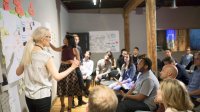Open Space Technology: Decision by Inclusion
See where Edcamps and Unconferences got their start with Open Space Technology, an inclusive decision-making model for crowdsourcing the best ideas in your school or classroom.
Your content has been saved!
Go to My Saved Content.The first time I heard of Open Space Technology was in 2013 at the initial meeting of the Teacher Resistance and Action Network, a group of teachers and education practitioners who had gathered under the guidance of Dr. Thomas Poetter of Miami University to discuss how to teach responsibly in the age of high-stakes testing. My friend and mentor, Kevin Lydy, had invited me to attend what was billed as a non-conference. It was a life-changing experience, not only because of the great conversations that I had with fellow educators, but also because I learned about a technique that I'd never heard of before: Open Space Technology. Some Edutopia readers may be familiar with Edcamps, which are, in fact, based on (and utilize) OST. Edcamps, however, are geared toward collaborating across schools and districts, while this post will focus on using OST within a school (or even your own classroom) to realize similar benefits.
Having now used OST at my school in staff meetings, in our strategic planning process, and even my own classroom, I have to agree with OpenSpaceWorld that "OST is a simple way to run productive meetings for five to 2,000+ people, and a powerful approach to leadership in any kind of organization." Harrison Owen, author of the short handbook Open Space Technology: A User's Guide (PDF), was inspired to codify the practice shortly after a the conclusion of a major conference that he'd helped plan for over a year. He was struck by a majority of attendees expressing that, for them, the most productive parts of the event had been the conversations that took place in between sessions, during the coffee breaks.
This led him to ask the question: "Is it possible to combine the level of synergy and excitement present in a good coffee break with the substantive activity and results characteristic of a good meeting?" Fortunately for us, the answer was yes. According to Owen, "It started with the notion that if I could identify certain basic mechanisms of meeting, or human gathering, it might be possible to build them into an approach that would be so simple that it could not fail, and so elemental that it might possess the natural power of a good coffee break."
How OST Works
OST begins with four simple "rules" or assumptions about the meeting. Dean Meyer has created a very useful illustration of these rules. The reason it's called a non-conference is that the attendees make up the agenda as the first order of business. This is typically done in a large-group setting, with participants writing session ideas on large notecards. Then the moderator reads the cards aloud, starting a discussion over ways to reframe or combine the sessions. The only thing needed to get a proposal onto the agenda is a willing "convener," whose job is being at a specific place and time and taking notes about what's discussed.
Once the agenda is agreed upon, participants attend sessions just like a regular conference. The biggest exception is that during the sessions, they're encouraged to self-organize by using the Law of Two Feet, whereby they move to another session if they feel they're not contributing to or getting anything out of the one they're attending.
At my school, we've now used OST in multiple settings with diverse groups of people. Perhaps most importantly, it's been part of our strategic planning process. Many of the challenges (and brainstorms for potential solutions) that came to light at the end of the previous school year served as the foundation for the strategic plan development process that we recently concluded. The range of ideas generated spanned everything from curriculum development to our school's waste disposal method. For example, one teacher convened a session simply because she wanted to know what kinds of projects other teachers were doing. This resulted in the idea for a new project database that teachers are now creating over the summer as part of their professional development. Another teacher who was passionate about sustainability convened a session on how to get our school to become a Zero Waste school, the outcome of which is now a part of our strategic plan.
One of the keys in utilizing OST is the opening session. When participants gather to generate session ideas, it's the moderator's job to help find topics that can be merged. For example, I employed OST in my Journalism class when I was struggling with a practical way to get 20+ middle and high school students to agree upon what our school’s first student newspaper should look like. By moderating the opening session, I was able to help them divide into areas that needed attention, such as the website design, the roles needed within the student newsroom, and the story publishing process.
Why Use OST?
Admittedly, not everyone will buy into the idea, but OpenSpaceWorld points out that the perfect time to use OST is when "the work to be done is complex, the people and ideas involved are diverse, the passion for resolution (and potential for conflict) are high, and the time to get it done was yesterday." I’ve found this assessment of OST’s capabilities to be true time and time again. Each time that I've used OST, the results were authentic, and participants left ready to work on accomplishing a shared vision.
You may say that you don't have time for something like this at your school, but I'd argue that you don’t have time not to use it. Whether you're ready to revolutionize your staff meetings, plan your next professional development day, or mobilize and unleash your students' creativity, this tool will help you. Learn more about how to use it at OpenSpaceWorld's Experiment page, and begin transforming your school.
